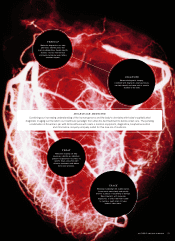GE 2003 Annual Report Download - page 3
Download and view the complete annual report
Please find page 3 of the 2003 GE annual report below. You can navigate through the pages in the report by either clicking on the pages listed below, or by using the keyword search tool below to find specific information within the annual report.
next-gen ene≥gy
Technology-driven energy efficiency reduces customers’ operating costs and earns GE a premium on the products
that deliver those savings. No wonder, then, that GE is focused on extracting the most from any given fuel— oil, natural gas,
hydrogen, wind, sun— through the use of advanced materials, designs and processes in all of its products.
wind
More than 2,000 1.5 megawatt wind turbines
from GE are providing power worldwide. In 2003,
GE began to infuse its wind turbine designs
with GE technologies— power electronics, drive-
trains from off-highway vehicles, and blade
materials and designs.
hyd≥ogen
Hydrogen can produce three times
the energy per gram of natural gas
with no greenhouse gas emissions.
In 2003, GE researchers made
strides in storage technology, a key
challenge in building tomorrow’s
hydrogen economy.
fuel cell
GE researchers are developing
solid-oxide fuel cells that are
big enough to power neighborhoods
and reduce greenhouse gas emissions.
In 2003, they developed durable
metals that can perform far longer
in the intense heat within
the fuel cell.
ge 2003 annual ≥epo≥t14
h system
GE’s breakthrough turbine technology entered
commercial service in 2003. Its advanced
materials and design result in the capability
for a record 60% thermal efficiency vs.
combined-cycle turbines’ average of 55%.
photovoltaics
The challenge is to make sunlight
a cost-efficient source of power for
tomorrow’s cities. Last year, GE scientists
investigated new solar designs that will
use up to 40% fewer costly silicon wafers
in rooftop semiconductor devices that
convert sunlight into electricity.
















